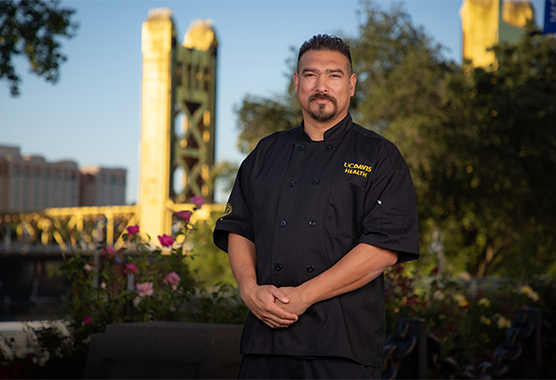Hospital food has often been seen as an unappealing option for those who find themselves in a hospital room or cafeteria.
At UC Davis Health, however, that food landscape has been transitioning into a true farm-to-fork healthy food program since the on-boarding of their new executive chef. Visitors, patients, and employees are now able to enjoy locally sourced, world-class cuisine menu options thanks to the inspired vision of executive chef, Santana Diaz.
Chef Santana oversees UC Davis Health’s production kitchen – one of the largest in the region – serving more than 6,500 meals a day at three locations on the Sacramento campus.
“Cooking has always been a part of my family. I was able to learn and cook alongside my grandma since I was a kid,” Santana says.
Finding his calling
Santana grew up in Yuba City, a small-town agriculture community about 45 minutes north of Sacramento. There was always a focus on fresh produce and cooking side-by-side with his grandma and family.
“We weren’t part of an affluent community, but we always had access to fresh seasonal produce given the rooted connections my family had with the food labor community. We didn’t focus on nor know much about highly processed foods and unnecessary added preservatives. A focus on fresh ingredients and real food is what actually set the stage moving forward for me.”
Keeping it simple and not always over-manipulating the ingredients is what paved the way for what is already a storied career in the food industry, and the farm-to-fork movement itself.
Before joining UC Davis Health, Diaz had created the systems and recipes for executing the first 90% sourced within 150-mile radius food program for the sporting world as the executive chef of the Golden 1 Center (home of the NBA Sacramento Kings). Santana decided that working at large scale institutions like football stadiums and arenas offered him the opportunity to assist farmers and ranchers with procurement forecasting while showcasing quality seasonal foods to the masses.
Diaz had previously honed his skills at a variety of restaurants, including the highly regarded Taste Restaurant in Plymouth and The Firehouse in Old Sacramento before taking on the logistical challenges of large-scale food production and sourcing for venues servicing capacities upwards of 70,000 per event.
When he got a call from UC Davis Health, the first thought in his mind was: can a hospital really do a farm-to-fork program?
“The stigma of hospital food had maybe been one step above airline food. I had never anticipated putting my reputation on the line for hospital food until after speaking with UC Davis Health. It was clearly communicated from the UC Davis Health executive leadership that they wanted to change that. We decided if we really wanted to make a difference, we’d need to look at the existing program, create and support a new plan, and then build a new food procurement model,” Santana explains.
Throughout his career, Santana had built up a roster of farmers and ranchers he sourced from to execute the large food programs with the teams he had been a part of. He has personally gotten his feet muddy, scouted fields of produce, and seen where the production and processing of foods was really taking place – always wanting to create a transparent food program for the end guest.
“When it comes to food, we’re incredibly fortunate that our medical center is located right here in the Sacramento Valley,” Diaz said. “We’re surrounded by farms and ranches, orchards and crops. We actually have the ability to keep things local, sustainable, and very healthy. Our goal is to source most of the entire food program from within 250 miles of our hospital campus, which is probably unheard of for a kitchen of this size.”
We all have a connection with food. It’s a very intimate relationship that each and every one of us have. When we reduce the unnecessary additives and preservatives of the food we consume, educate our patients, visitors and staff, we ultimately make a healthier community.—Executive chef Santana Diaz
Discovering healthy
By purchasing much of its food from sources almost within view of the hospital’s tallest tower, UC Davis Health can reduce delivery mileage and fuel consumption, lower its carbon footprint, and provide a healthy economic boost for locally produced, high-quality foodstuffs, according to Santana.
“When we’re able to forecast with a local farmer we provide not only a source transparent program, but also yield an important community benefit. We’re able to work with farmers, through chef inspired menu engineering, and provide them with the produce volumes needed for the year so they can plan and plant ahead. We find value in meeting with our ranchers and processing companies by literally placing my feet on the ground and making a connection.”
“Does it make sense to truck in tomatoes from another country when we have so many tomato farms within 50 miles? It’s always going to taste better if we use foods that are in season.”
Santana believes that not only is this process creating healthier food, it’s creating a healthy education for the hospital’s staff and those who visit.
“We all have a connection with food. We all consume a meal or snack 3-5 times a day. It’s a very intimate relationship that each and every one of us have. When we reduce the unnecessary additives and preservatives of the food we consume, educate our patients, visitors and staff, we ultimately make a healthier community.”
Santana hopes UC Davis Health’s Food and Nutrition Services food operation becomes a model for the other health care facilities around the state, even around the country. Commitments to sustainable, healthy food practices that promote healing and long-term health is the ultimate goal.
After all, as Chef Santana likes to say, “Good food is good medicine.”

